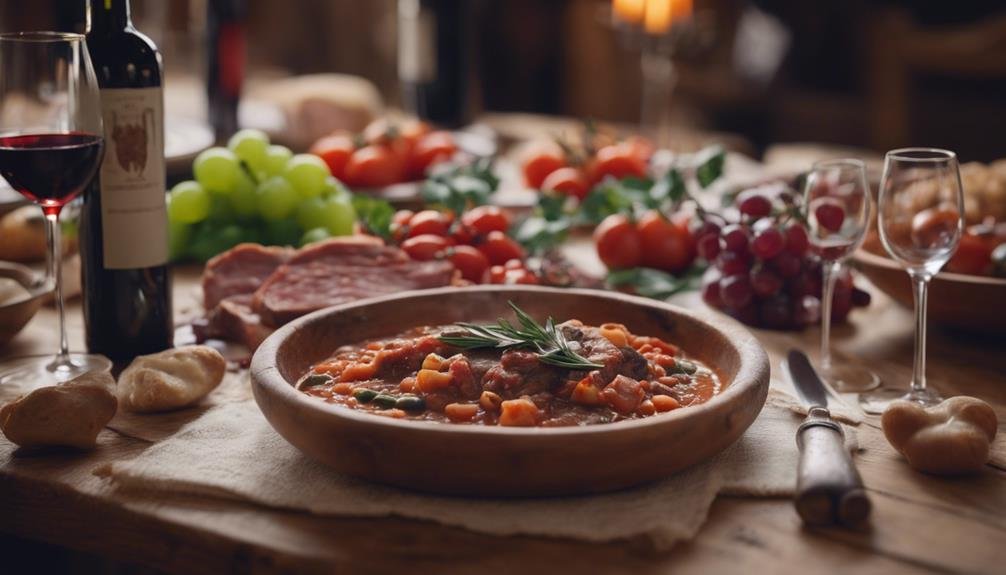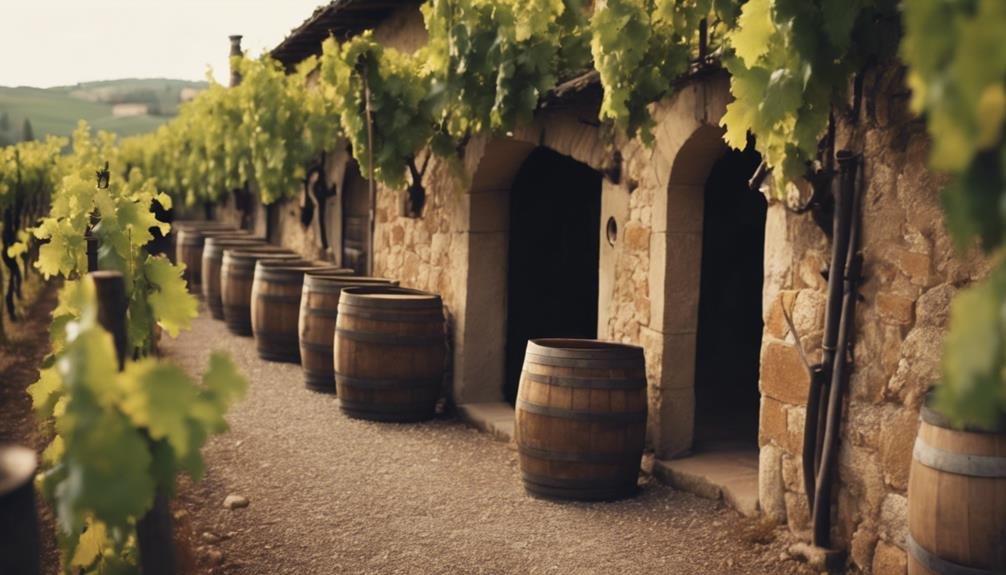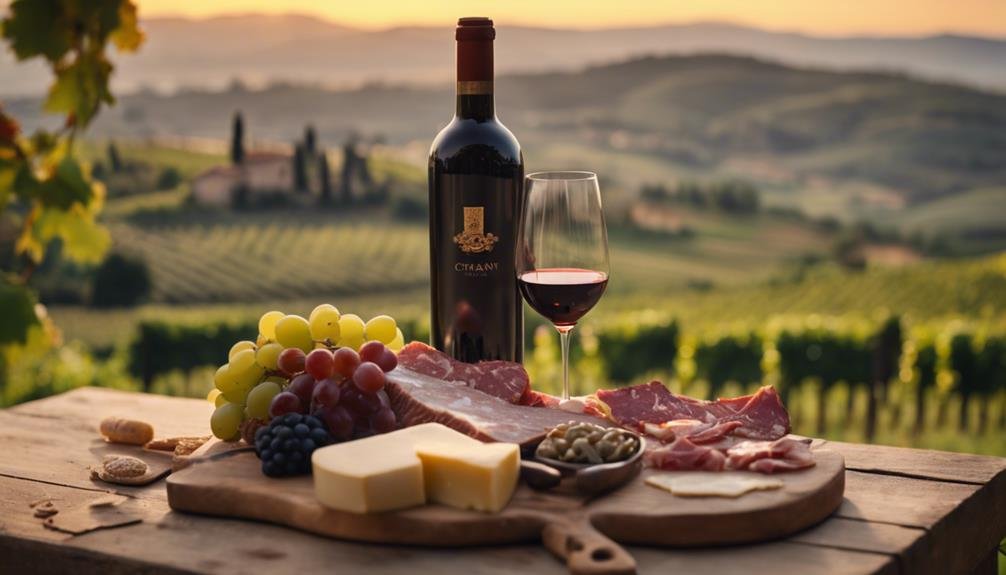Chianti wine, a renowned red blend from Tuscany, Italy, is primarily crafted with the Sangiovese grape variety. It offers a unique sensory experience with notes of red fruits, herbs, and balsamic vinegar. The region's production involves a careful selection and blending of grapes like Canaiolo, Colorino, Cabernet Sauvignon, and Merlot. Ideal pairings include richer fatty dishes, tomato sauces, and pizza to enhance its high acidity and coarse tannins. Discover the rich flavors of Chianti wine, the picturesque region it originates from, and the perfect pairings to elevate your dining experience.
Chianti Wine Overview
Chianti wine, a renowned red blend hailing from the picturesque region of Tuscany, Italy, is primarily crafted using the Sangiovese grape variety. This choice imparts a unique sensory experience characterized by notes of red fruits, dried herbs, and a distinct touch of balsamic vinegar.
Chianti production revolves around the careful selection and blending of Sangiovese grapes, known for their thin skin, resulting in a pale-colored wine. Additional grapes such as Canaiolo, Colorino, Cabernet Sauvignon, and Merlot may complement the Sangiovese, adding complexity to the final product.
The classic Sangiovese characteristics of coarseness and tartness shine through in Chianti wines, offering a true taste of Italy and a memorable drinking experience for enthusiasts.
Sangiovese: The Heart of Chianti
Sangiovese, the predominant grape variety in Chianti wines, plays a pivotal role in defining the distinctive flavor profile of this renowned Tuscan red blend. This grape varietal imparts classic Sangiovese characteristics to Chianti, such as coarseness and tartness, creating a wine with high acidity and coarse tannins. Known for its thin skins and pale color, Sangiovese contributes flavors of red fruits, dried herbs, balsamic vinegar, smoke, and game to Chianti wines.
While Sangiovese is the main grape used, Chianti blends may also contain Canaiolo, Colorino, Cabernet Sauvignon, or Merlot. The best examples offer a visceral Italian grocery store experience, capturing the essence of Tuscany in a bottle.
Chianti Food Pairing Guide

When considering food pairings for this renowned Tuscan red blend, it is essential to complement its savory flavors, high acidity, and coarse tannins with dishes that enhance its unique characteristics. Chianti wines shine when paired with richer fatty dishes, tomato sauces, and pizza, offering flavorful combinations that elevate the dining experience. Gastronomic delights await those who explore pairing Chianti with olive oil-based dishes and rich meats like Bistecca Alla Fiorentina. To achieve pairing perfection, consider trying Chianti with tomato-based pasta sauces, pizza, or the classic Florentine steak. These culinary adventures will enhance the flavors of both the wine and the food, creating an unforgettable dining experience.
| Food Pairing | Description |
|---|---|
| Rich Fatty Dishes | Complements Chianti's savory flavors and acidity |
| Tomato-Based Pasta Sauces | Enhances the wine's unique characteristics |
| Bistecca Alla Fiorentina | Perfectly pairs with Chianti's coarse tannins |
Exploring Chiantis Tuscany Region
Nestled within the picturesque landscapes of Tuscany, the region of Chianti unfolds with a rich tapestry of vineyards and diverse terroirs awaiting exploration. The Tuscan landscapes, with their rolling hills and historic charm, provide the perfect backdrop for the cultivation of Chianti wines.
Local wineries dot the countryside, each offering a unique perspective on winemaking traditions passed down through generations. These wineries not only showcase the artistry of Chianti production but also provide a glimpse into the deep-rooted cultural significance of wine in the region.
Exploring the Tuscany region allows for an immersive experience, where visitors can witness firsthand the dedication and passion that go into creating the renowned Chianti wines.
Aging and Classifications of Chianti

The aging process and classifications of Chianti wines play a crucial role in determining their complexity and aging potential, reflecting the diverse expressions of this renowned Italian red blend.
Aging effects on Sangiovese in Chianti wines vary based on the labeling terms used, such as Chianti, Superiore, Riserva, and Gran Selezione. Each classification offers distinct aging durations and characteristics, influencing the flavor profiles of the wines.
Gran Selezione wines, for instance, are intense with sought-after flavors, showcasing the pinnacle of Chianti's aging potential.
Frequently Asked Questions
What Makes Chianti Wines Age-Worthy?
Chianti wines age-worthiness stems from their inherent characteristics like high acidity, firm tannins, and complex flavor profiles. Winemaking techniques such as extended oak aging and careful grape selection contribute to their aging potential, ensuring development of sought-after flavors.
Are There Any Organic or Biodynamic Chianti Producers?
Many Chianti producers embrace organic or biodynamic practices, prioritizing sustainability in winemaking. These methods, differing from conventional approaches, emphasize natural techniques and environmental harmony. Such dedication to organic and biodynamic principles underscores a commitment to quality and eco-consciousness.
Can Chianti Wines Be Used in Cooking?
Chianti wines can be excellent additions to culinary creations. Their high acidity, savory flavors, and coarse tannins make them ideal for cooking techniques like braising and deglazing. Pair with rich meats, tomato-based dishes, and experiment in various recipes for delicious results.
How Do Different Oak Aging Methods Affect Chianti?
Different oak aging methods notably impact Chianti wines, changing their flavor profiles and aging potential. Oak influence can improve complexity and quality markers like depth and structure. Understanding these nuances is essential for appreciating diverse Chianti styles.
Are There Any Famous Landmarks in the Chianti Region?
The Chianti region in Tuscany boasts a rich cultural heritage and historical significance. Famous landmarks like the Castello di Brolio, the Abbey of Passignano, and the town of Radda in Chianti offer visitors a glimpse into Italy's storied past.
Conclusion
To sum up, delving into the world of Chianti wine is akin to peeling back the layers of a scrumptious onion, uncovering the intricate flavors and nuances that define it as a beloved Italian classic.
From the heart of Tuscany to the traditional food pairings, Chianti offers a sensory journey that enchants wine enthusiasts around the globe.
So, raise a glass of Chianti, relish the essence of its terroir, and immerse yourself in the cultural tapestry woven into each sip.
Cheers to the timeless allure of Chianti wine!
